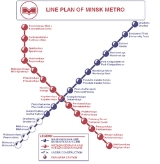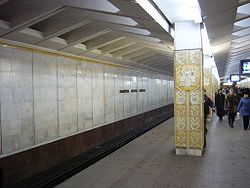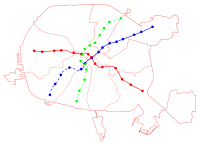
Minsk Metro
Encyclopedia

Minsk
- Ecological situation :The ecological situation is monitored by Republican Center of Radioactive and Environmental Control .During 2003–2008 the overall weight of contaminants increased from 186,000 to 247,400 tons. The change of gas as industrial fuel to mazut for financial reasons has worsened...
, the capital of Belarus
Belarus
Belarus , officially the Republic of Belarus, is a landlocked country in Eastern Europe, bordered clockwise by Russia to the northeast, Ukraine to the south, Poland to the west, and Lithuania and Latvia to the northwest. Its capital is Minsk; other major cities include Brest, Grodno , Gomel ,...
. Opened in 1984, it presently consists of 2 lines and 25 stations totaling 30.3 kilometres. In 2005 it carried 800,000 passengers per day.
Lines and stations
| # | Name | Opened | Length | Stations |
|---|---|---|---|---|
| 1 | Moskovskaya Moskovskaya Line The Moskovskaya Line , is a line of the Minsk Metro. The line was opened along with the Metro in 1984 with the original eight station segment, and crosses the city on a Northeast-Southwest axis... |
1984 | 12.2 km | 11 |
| 2 | Avtozavodskaya Avtozavodskaya Line Avtozavodskaya Line is a line of the Minsk Metro. The line opened in 1990 and crosses the city on a Northwest-Southeast axis. Currently it comprises 14 stations and 18.1 kilometres of track.-Timeline:-Transfers:-Rolling stock:... |
1990 | 18.1 km | 14 |
| Total | 30.3 km | 25 |
History
During the 1950s-1970s the population of the city soared over a million and designs for a rapid transit system were initially put up during the late 1960s. Construction began on 16 June 1977, and the system was opened to the public on 30 June 1984, becoming the ninth metro system in the Soviet UnionSoviet Union
The Soviet Union , officially the Union of Soviet Socialist Republics , was a constitutionally socialist state that existed in Eurasia between 1922 and 1991....
. The original eight station section has since expanded into a two-line 25 station network with 30.3 kilometres of track.
Despite the dissolution of the Soviet Union
Dissolution of the Soviet Union
The dissolution of the Soviet Union was the disintegration of the federal political structures and central government of the Union of Soviet Socialist Republics , resulting in the independence of all fifteen republics of the Soviet Union between March 11, 1990 and December 25, 1991...
the construction of Minsk metro continued uninterrupted throughout the 1990s (as opposed to other ex-Soviet Metros like those of Yerevan
Yerevan Metro
The Yerevan Metro is a rapid transit system that serves the capital of Armenia, Yerevan. The system was launched in 1981 and like most former Soviet Metros, its stations are very deep and intricately decorated with national motifs. The metro runs on a 13.4km line and currently services 10 active...
and Samara
Samara Metro
Samara Metro , formerly known as the Kuybyshev Metro , is a rapid transit system which serves the city of Samara, Russia. Opened in 1987, it consists of one line with 9 stations and 11.4 km of bi-directional long track.-History:...
, which were halted due to a complete lack of funding). Some experts attribute it to the slow reform of the Soviet planned economy in Belarus, which turned out to be beneficial for the metro expansion. Currently, station launch dates are ahead of original schedule. For example, the final phase of the Avtozavodskaya Line, originally planned for 2006, was opened in late 2005, and similarly the northern extension of the Moskovskaya Line, originally scheduled for 2008, opened on 7 November 2007.
Timeline
| Date | Opening |
|---|---|
| 1984-06-26 | Institut Kul'tury – Moskovskaya |
| 1986-12-30 | Moskovskaya – Vostok |
| 1990-12-31 | Traktorniy Zavod – Frunzenskaya |
| 1995-07-03 | Frunzenskaya – Pushkinskaya |
| 1997-11-07 | Traktorniy Zavod – Avtozavodskaya |
| 2001-09-05 | Avtozavodskaya – Mogilyovskaya |
| 2005-11-07 | Pushkinskaya – Kamennaya Gorka |
| 2007-11-07 | Vostok – Uruchye |
Operational characteristics

The city is located on an almost level surface and on very dry soils. As a result, although all of the Minsk Metro stations are under the surface, there are no deep-level stations that are found in most of the ex-Soviet cities. Out of the current 25 stations 16 are pillar-spans and 9 are of vaulted type. Like most of the Soviet metro systems, all of the stations are vividly decorated. Some (notably, Nyamiha/Nemiga) exhibit Belarusian national motifs, others focus on more Soviet socialist themes
Socialist realism
Socialist realism is a style of realistic art which was developed in the Soviet Union and became a dominant style in other communist countries. Socialist realism is a teleologically-oriented style having its purpose the furtherance of the goals of socialism and communism...
. Although recent years saw more priority on high-tech decorations.
Expansion plans

At present, there are several projects, only one of which is under construction, the southwestern three-station extension of the Moskovskaya line to the new residential districts in the south-west of the city. A further station may be added afterwards. Avtozavodskaya Line can potentially receive an extension on both of its ends.
However, the major project after 2010 will be a third line running from the south to the north-east of the city via the centre, creating 2 new transfer points to the existing lines. The construction of the third line is expected to start in 2011; the first stage of the line is expected to open in 2017. This would follow a northern contour parallel to Moskovskaya, and relieve the extensive congestion build up, and then extend south of the city.
A fourth line is not expected to be built before 2015. It will connect south-eastern parts of the city with the north-western residential areas.

